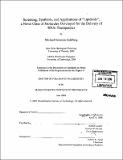Screening, synthesis, and applications of "lipidoids", a novel class of molecules developed for the delivery of RNAi therapeutics
Author(s)
Goldberg, Michael Solomon
DownloadFull printable version (15.37Mb)
Other Contributors
Massachusetts Institute of Technology. Dept. of Chemistry.
Advisor
Robert Langer.
Terms of use
Metadata
Show full item recordAbstract
RNAi therapeutics represent a fundamentally new way of treating disease, permitting the selective abrogation of protein production at the genetic level. As nucleic acids do not readily enter cells, carriers are utilized to enhance uptake. While viruses are extremely efficient, concerns about their safety has led to the desire to engineer novel synthetic vectors. We have developed chemical methods using a combinatorial approach that has resulted in the synthesis of a large library of structurally-diverse compounds (1,200 in total), termed "lipidoids", without the need to use solvents, catalysts, or protection/deprotection steps. The members of this library were screened for the ability to transfect mammalian cells in vitro. The top-performing compounds were formulated for in vivo administration and resulted in durable, potent, and specific knockdown of reporter and therapeutically-relevant genes in four distinct species, including non-human primates. Local and systemic administration effectively silenced target genes in three different tissue types. In addition to reducing protein expression by directing cleavage of target mRNA through delivery of siRNA, lipidoids were shown to mediate upregulation of proteins by derpressing miRNA targets through delivery of anti-miR. Finally, inspection of the chemical functional groups common to the top-performing lipidoids from the first library informed the synthesis of a second-generation library. The dramatic increase in percentage of effective materials from this second library (52% as opposed to 3%) confirmed that a convergence of structure has been identified.
Description
Thesis (Ph. D.)--Massachusetts Institute of Technology, Dept. of Chemistry, 2008. Vita. Includes bibliographical references.
Date issued
2008Department
Massachusetts Institute of Technology. Department of ChemistryPublisher
Massachusetts Institute of Technology
Keywords
Chemistry.